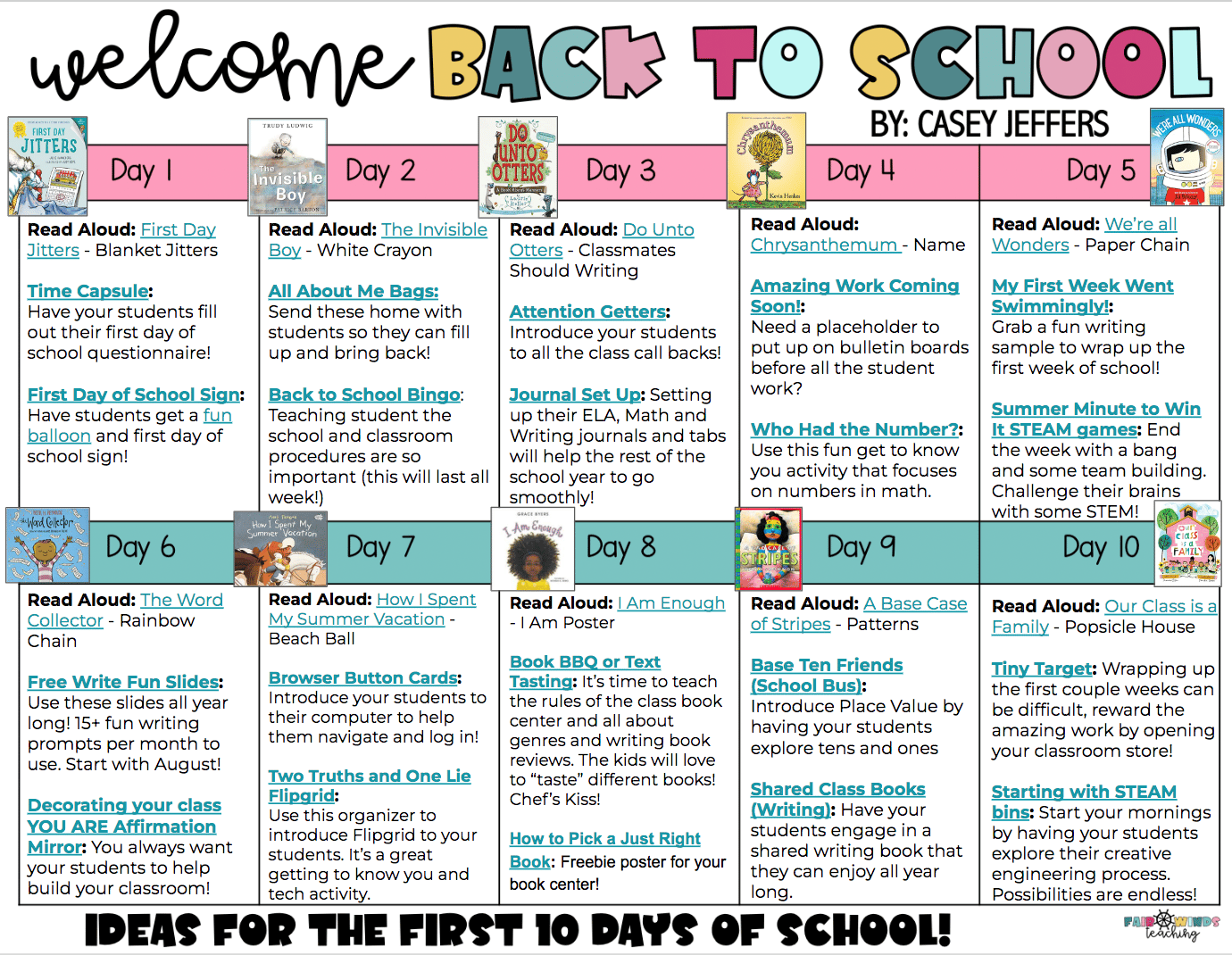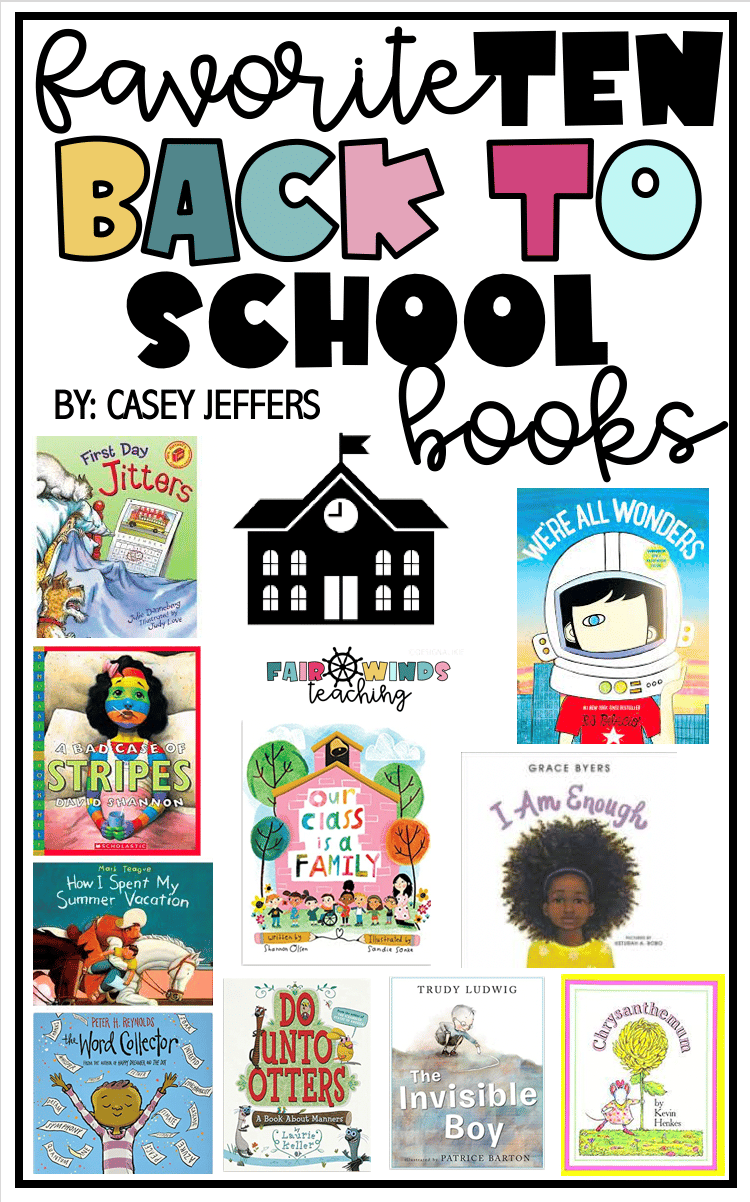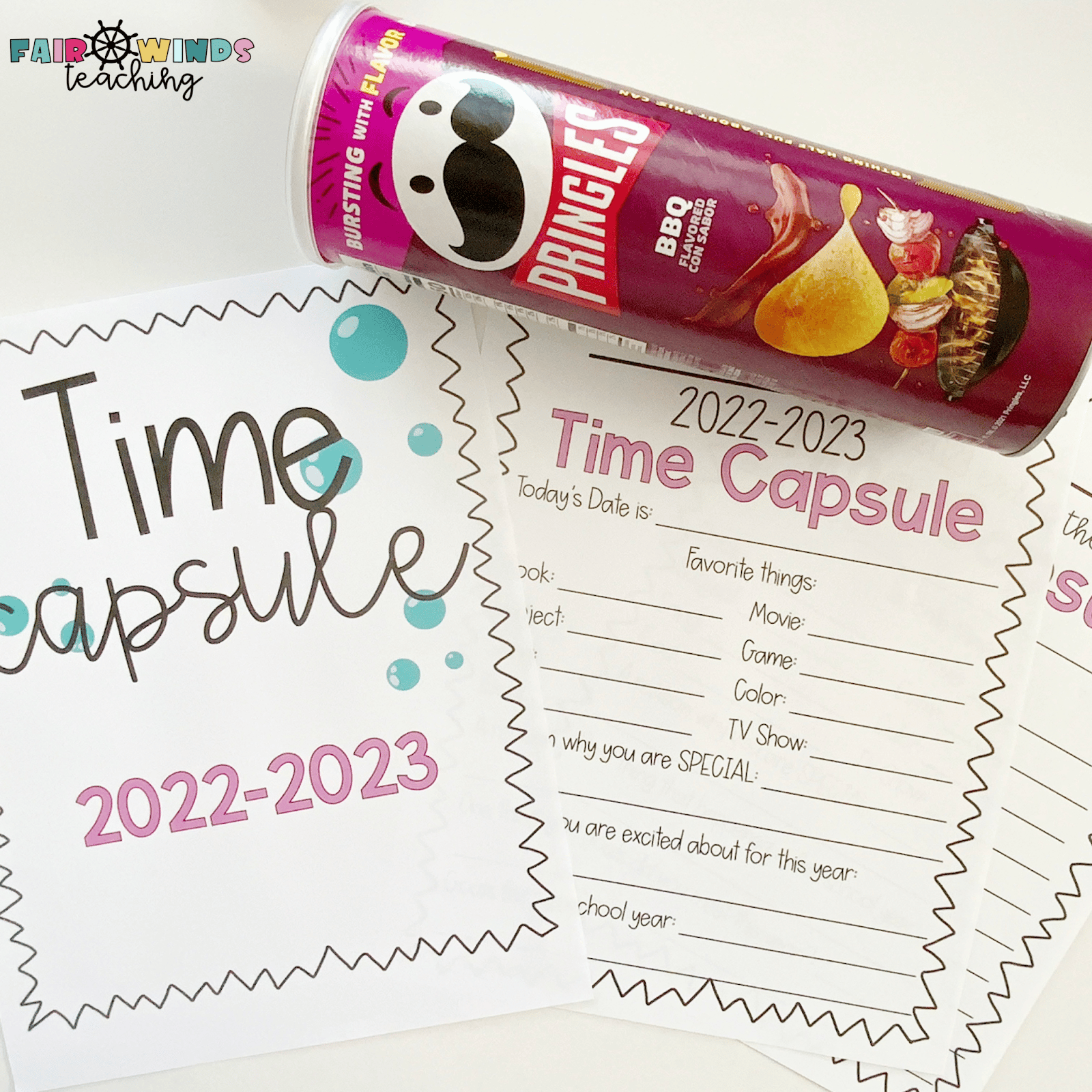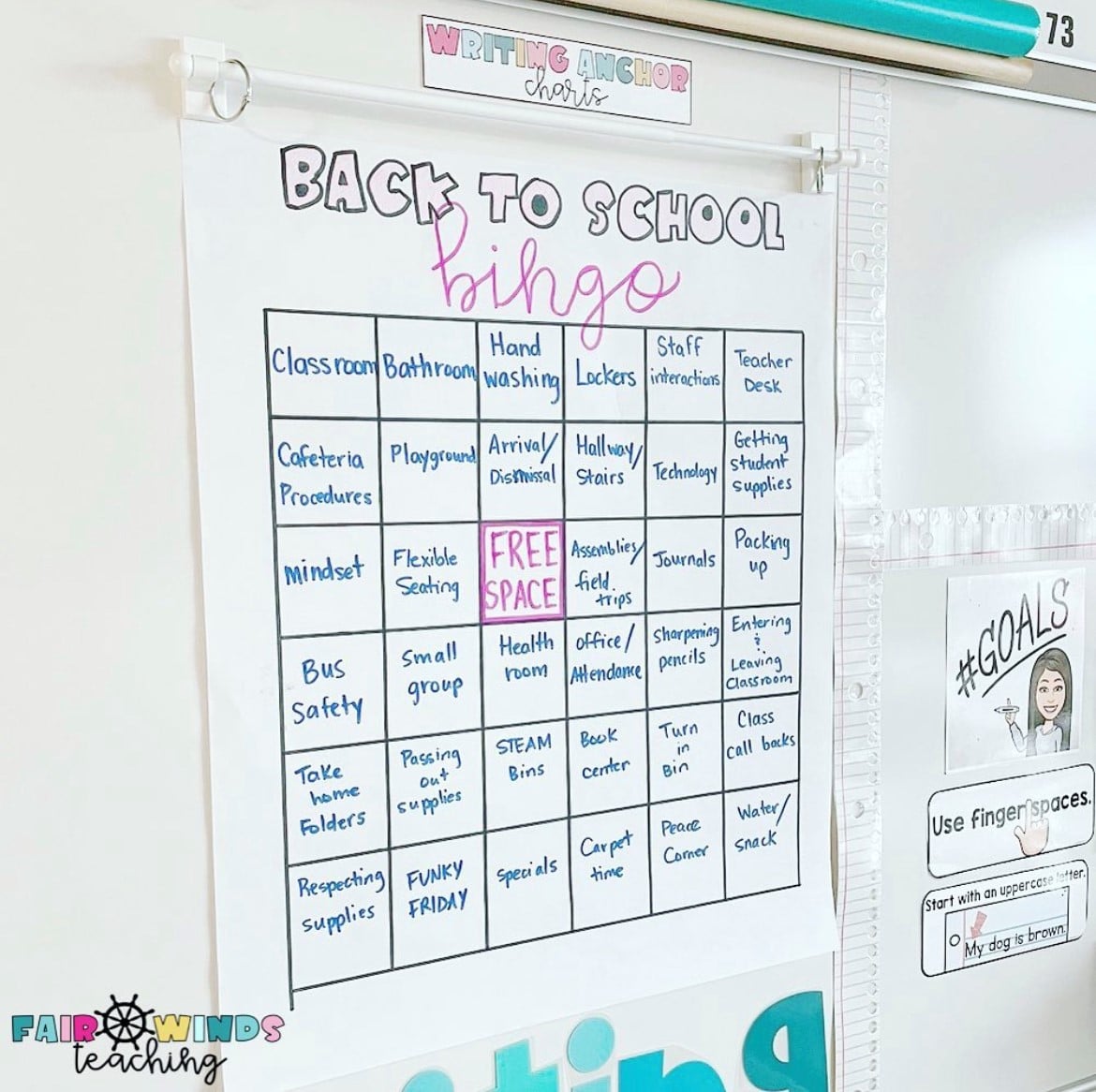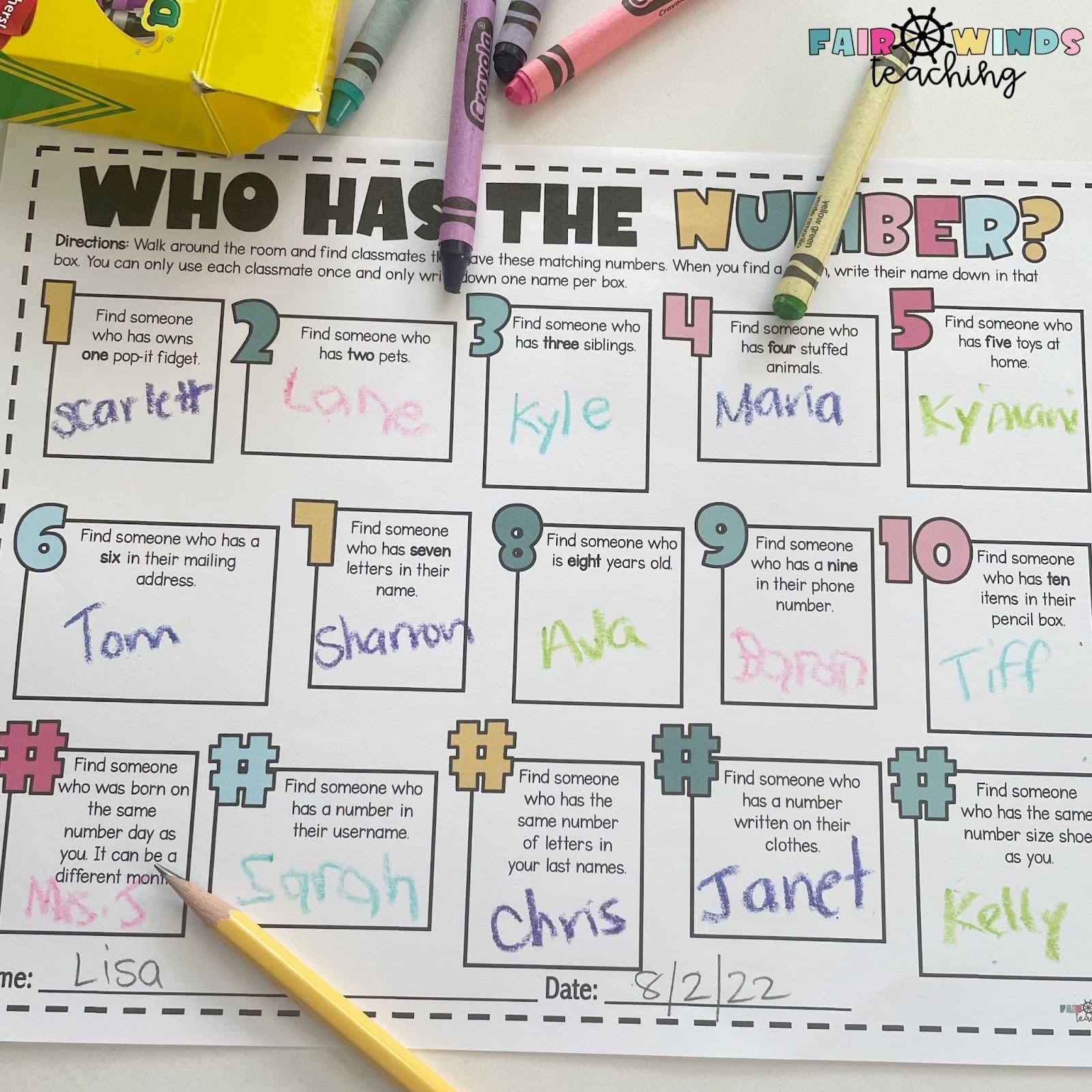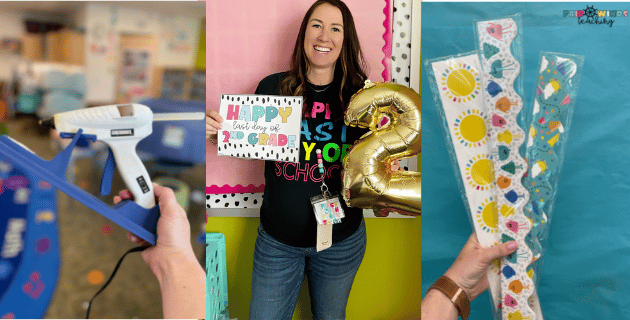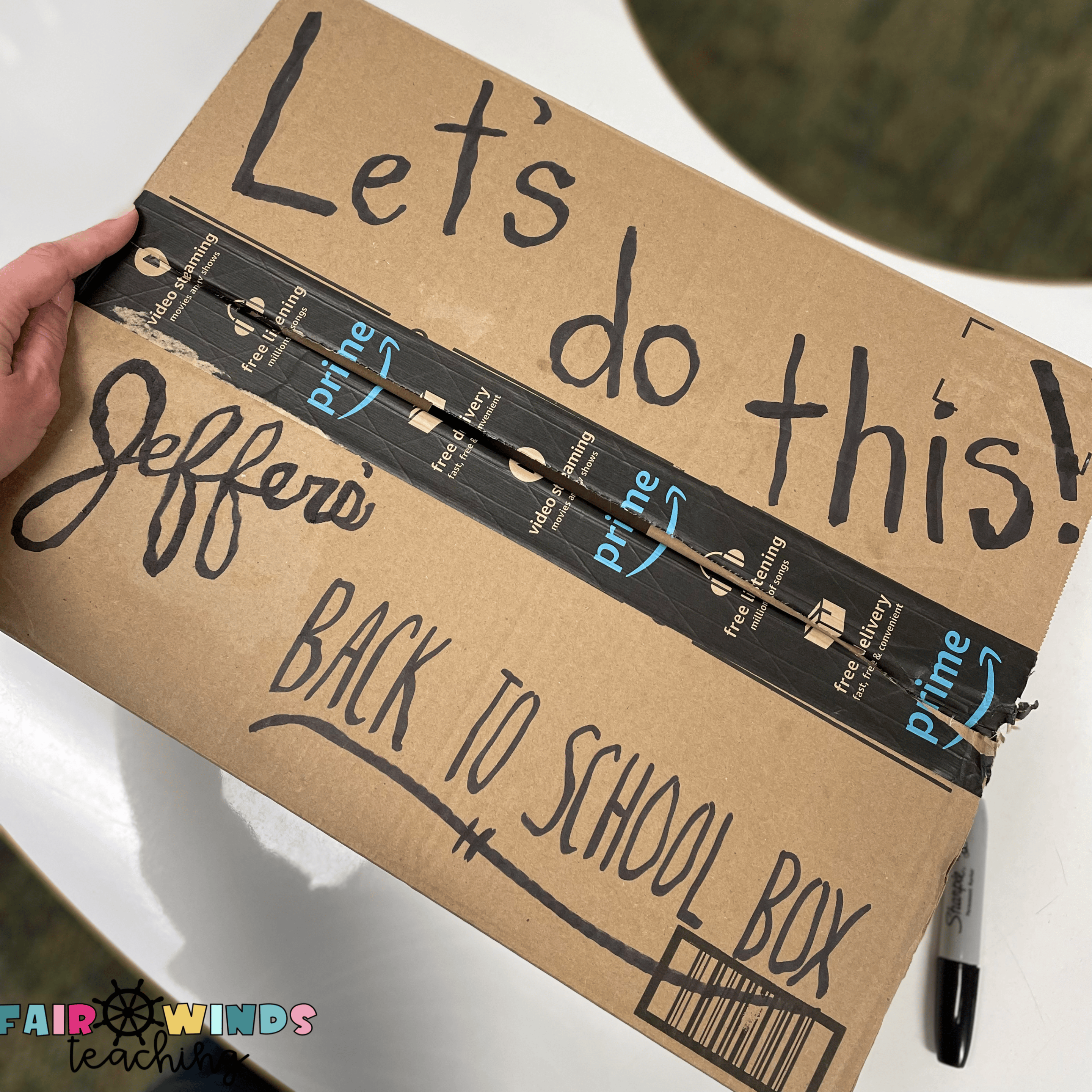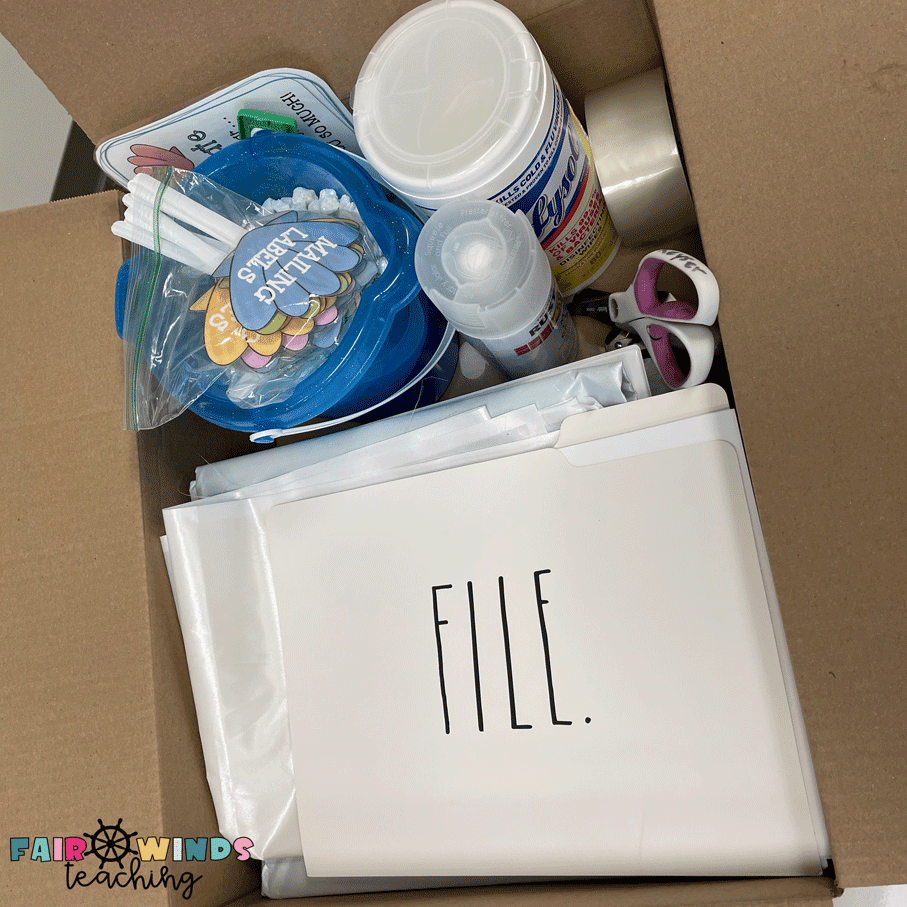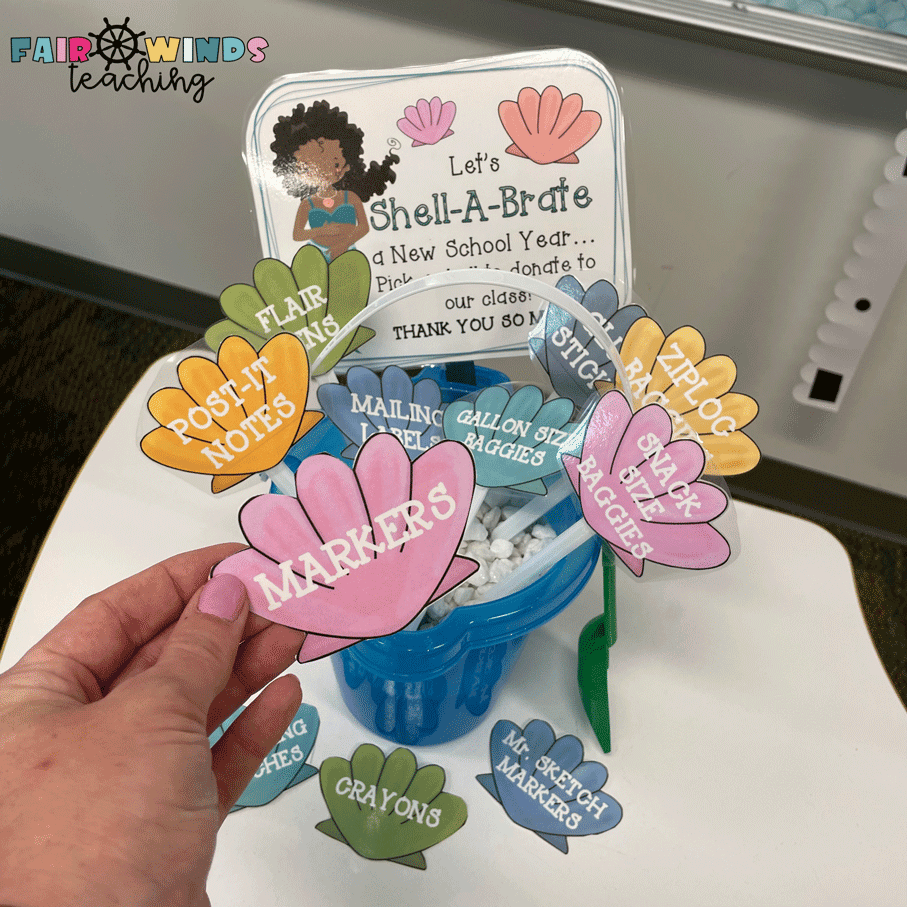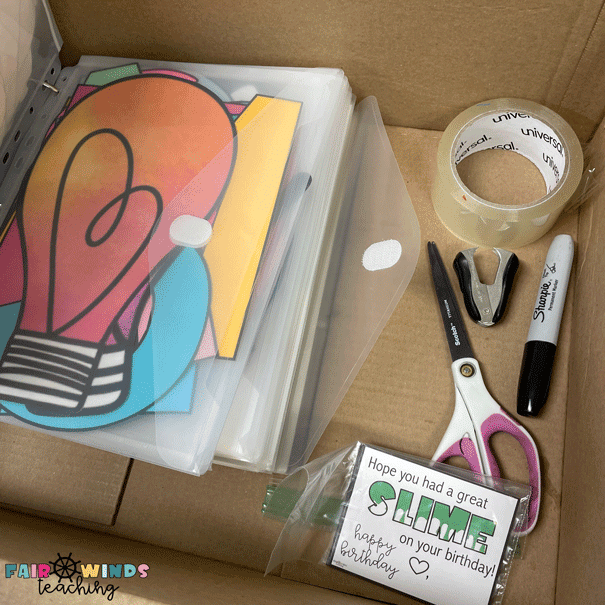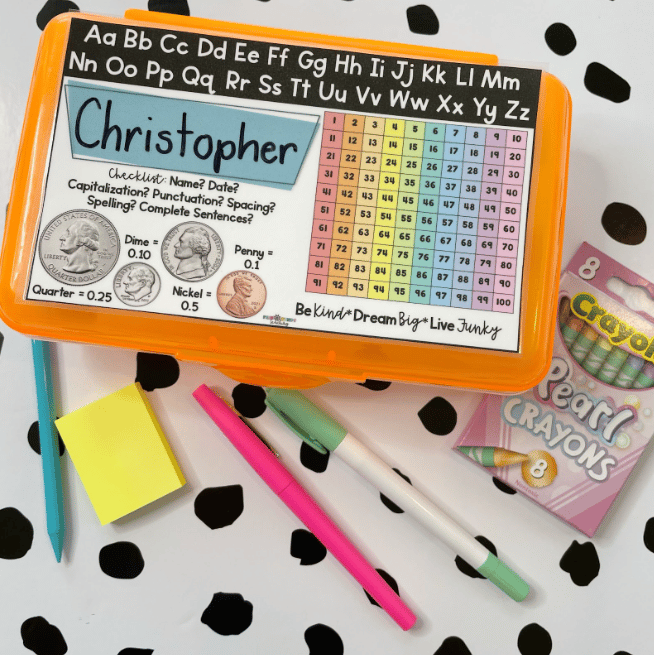
by California Casualty | Educators |
Written by Casey Jeffers, Owner of Fair Winds Teaching & MSEA Second Grade Teacher
Check out how I morph my classroom into an engaging learning lab for any subject! Anytime you can change up your student’s routine to engage them in a new learning experience is well WORTH IT! A classroom transformation creates an immersive experience for our students without having to leave the classroom.
I know that pulling off a classroom transformation can be stressful and overwhelming, however, if you follow these guiding points, you will be able to better understand what your day or week will look like beforehand.
First things first… ALWAYS START with the instructional goal/problem when planning a classroom transformation. You must have a standard or group of standards in mind to successfully complete a transformation. This is NOT about a theme or turning your classroom into an underwater shark tank, just because. You need to have a purpose…
My suggestion is to start by laying out the content you have been teaching and figure out what you are assessing your students on. This process will start about 2 weeks beforehand. Most subjects and content have the potential to lead to a classroom transformation idea. You just need to create those creative juices flowing!
For example, my class and I spent weeks learning how to measure distances and comparing lengths. We asked a lot of questions about diving into the water and compared two divers. This helped with the idea of having a Shark Diving day to help measure and compare sharks and divers. I started with the content and let the idea come to me. I would not suggest scrolling through Pinterest and just selecting a circus theme because you think the kids will like the circus.
If you are teaching elementary measurement standards this school year, check out this Shark Classroom Transformation here!
Next up, here are 5 questions you should ask yourself when planning your own classroom transformation or buying someone else online.
5 Questions to Ask Yourself When Planning a Classroom Transformation
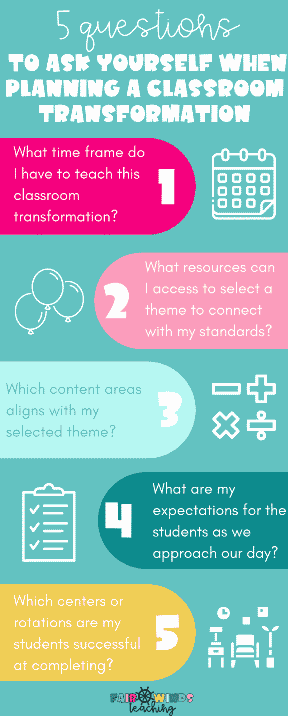
- What time frame will you have available to complete your classroom transformation? Is it a one-day or a week-long unit? Plan so you know how many centers, activities, or lessons you will need.
- What decoration resources/materials do you already have available to you that connect with your standards? Selecting the theme is the fun part! Think about – (kids’ birthday parties you have leftover decorations from, companies that can partner with to provide materials (Crumbl Cookie, Starbucks), or what is currently available at the dollar store) If you don’t have anything to start with, ask yourself… What are your students interested in? Poll them and see what is fresh and new! This might help spark an idea that connects with your standards.
- Can this theme/topic be connected over multiple content areas? Math, reading, and writing? Can you extend a restaurant theme over the science content you are currently working on? Can you add a STEAM or physical education component to your day?
- What expectations do I have for my students on an “out of the box” day like this? Make this clear to them beforehand. This will help plan your centers/activities accordingly.
- How many center/rotations or groups can they handle? Do you run a teacher-led group? Do you have other adults to help you on that day? Is a worksheet their best use of time or does every station need a recording sheet?

If you ask yourself these questions while designing or buying a classroom transformation, you have already set your students up for success. The day will go amazing and the kids are sure to remember the experience and content learned for years to come.
Let’s dive into some of the classroom transformations I have created for my 2nd and 3rd graders. We have transformed our room into a backyard BBQ and restaurant to have a book tasting or barbeque.
We have dressed up for the 101st day of school and transformed into the 101 Dalmation movie for the entire day!
We’ve taken on the world of road construction to assess area and perimeter for our all-week classroom transformation. Hard hats included!
My favorite of all time was our sweet-smelling bakery for our Crumbl Cookie day to learn about shapes and fractions! They had a blast and it also tasted amazing!

Whether you are ready to start designing your own classroom transformations or using someone else’s idea, here are some tips and tricks I have learned along the way!
10 Tips and Tricks for a GREAT Classroom Transformation:
- Showing your work is a must
- Label all of their supplies and papers BEFORE you start (things will get left around the room)
- Have a visual timer to show rotations
- Have a checking-in process (team leaders or individual students)
- Review expectations before the day starts
- Set up the room beforehand (but not too far in advance (they will move and ruin your stuff) – Here is a FREEBIE to show you are working on the process
- Fun background music is a must! It is fun and keeps everyone quiet (Spotify – Follow me here)
- Decide what you are keeping (to use again) and what the students are able to keep (let them know ahead of time)
- Have a clean-up crew ready at hand
- HAVE FUN – take a step back and spend some time listening to them work in groups, you will be amazed at how engaged they are! (take lots of pictures to remember it by)


Casey Jeffers is a second-grade teacher at Butterfly Ridge Elementary in Frederick County, Maryland. She was recently recognized as the national winner of the NEA Foundation’s 2021 Teaching in Excellence Award. Casey is the proud owner of the Education Resource Blog, Fair Winds Teaching, and loves to connect with her education community through her TeacherPayTeacher’s business.

by California Casualty | Educators |
Written by Casey Jeffers, Owner of Fair Winds Teaching & MSEA Second Grade Teacher
Setting up your classroom library can be a daunting task. Whether you are a brand new teacher or a teacher switching grade levels (this is a big deal because not all books are appropriate for all ages). Here’s my guide to collecting books from multiple locations without breaking the bank!
Where do I get my books from?
My favorite website to buy classroom books is Scholastic Book Clubs! Check out the best ways to earn points and FREE books year-round. Then you also can’t beat the deals that they have each month, a lot of them being only $1 a book!
Earning BONUS POINTS – Always fill out your back-to-school form to update your class size to earn your 100 points each year, save ALL the emails from Scholastic throughout the school year to build up coupon codes for your next order, and have a notebook to write down codes when they come up on the Scholastic IG/Facebook pages. I collect so many points throughout the year to earn so many FREE BOOKS and school supplies! If you don’t have a Scholastic Book Club account yet, use this link to earn a FREE 250 Bonus Points from me!

Birthday Coupons – In the beginning of each school year, you get an offer to buy a class book of b’day coupons. Each pack comes with 30-32 FREE book coupons and they are each worth up to a $5 FREE book. That is upwards to $160 worth of books, for a cost of $30.00! I have bought these for my students in the past and handed them out for their birthdays. They are to take them home and select their book with their family online. I don’t do that anymore because most of them lost the coupon or forgot to log on and redeem their book. Instead, I have them work with me on their birthday to select a $4-$5 book (no less than that- getting the best value) to buy a book with the coupon code on my account to add to our classroom library. Then when it comes in the mail, that student gets to present it to the class as a gift! They get to put their name in the book as a donation, it makes them so happy. That stocks my classroom with 32 new books each school year for $30!

Family Book Orders – Making the Scholastic Book flyers available to your families helps build your points so you can buy some classroom books for your classroom as well. Here are some of my favorite tips for boosting family orders!
-
- Let families know that every order, no matter how small or big, earns FREE Books for your classroom. Use this pack to help boost sales and recommend your families! This gets families involved by sharing your Class Code for online ordering and letting them know they can choose a FREE $5 Book with every $25 online order with code READS.
- Share photos of all the FREE Books and resources your class has earned. A picture is worth a thousand words! I even do #BookBoxDay unboxing videos for my students and families!
- Send home reminder armbands with the due dates and their wish lists, both of these are available in this pack!

Family/Friends for Donations
The second place I go to collect books is simply by asking family and friends. I use my personal and professional social media platforms to post about a need for used or new classroom books. You would be surprised how many households are sitting on dozens of children’s books that they don’t use anymore. I’ve had families with high schoolers now that hadn’t gotten rid of any of their elementary-aged books and simply had them sitting in a box in their garage. They were happy to donate and get them out of their space. It never hurts to ask! I especially reach out to my retired teacher friends! Then I go through the books and then any repeats I have I offer to other new teachers or give to the students to take home to start their library.

Visiting Your Local Public Library
Have you ever been to your local public library? Did you know they are always getting rid of books that are now out of circulation? My grandmother used to volunteer at our local library and she would say that books that weren’t checked out super often, had too many copies, or were a little damaged would be taken out of circulation. These were always donated but sometime she would be able to bring some home to be (knowing I was a classroom teacher). It is always good to ask or give them your contact information in case they have books to get rid of.
Amazon Wish-lists (#ClearTheList)
Have you heard!!?? Celebrities, companies, influencers, and so many other people are helping to #ClearTheList of teachers’ Amazon wishlists! If you haven’t made one yet, it is your time to take a second and add classroom books and other amazing supplies!
How to make a list:
- Login to your Amazon account
- Go to “Account & Lists” at the top right corner
- Click on “Your Lists”
- Create a list (make sure it’s public)
- Add items or books that you find on Amazon (if you want some classroom list ideas, check my favorites out here!)
If you want to share it with friends & family, click “Invite,” copy the link, send it out, or share it on your social media pages.

Sponsors
If you make your Amazon wish list, reach out to some local companies or popular businesses online and see if they would be willing to help out and donate. I use Twitter and Linkedin to reach out to a lot in my local area. Write them a letter introducing yourself, telling them a little about your school and students, and then tell them how they can help.
Thrift Stores/Facebook Selling Groups-
One of my favorite summertime activities is strolling through a good thrift store. Whether it’s a GoodWill, Wonder Book & Video, ReStore, or any local company, you can find gently used books for a very cheap rate. Make sure to save your receipts so you can write them off your taxes!
You can also join your local Facebook teacher groups (mine is called Teachers Sell Stuff (city, State) and see if anyone has books available for purchase.
As you are selecting books for your classroom make sure you gather a wide variety of books. I try to have some leveled books, picture books, just for fun books, magazines, comics, graphic novels, chapter books, maps, and much more. Get creative, the kids love a diverse set of things to get their hands on.
Other Helpful Classroom Library Tips and Tricks:
Make sure to have book bin labels for your students to be able to find and organize their books. Here is the set I use to label my 2nd-grade classroom. Hang some signs to help students to select their “Just Right Book,” grab this FREEBIE here. I also make sure to label ALL books that come into my classroom so I don’t lose track of them. I use these mermaid ones on Avery shipping labels (30 per page).

Where to buy your bins?? My favorite places are Storex, Dollar Store, The Target Dollar Spot, Walmart, Ikea (have the kids decorate them), or the DIY option, start collecting cereal boxes now! Simply save larger cereal boxes and cut them down like the pictures below. Cover them with paper, spray paint them, or leave them with the kids’ favorite cereal pictures.
Good luck and happy building up your library! 🙂

Casey Jeffers is a second-grade teacher at Butterfly Ridge Elementary in Frederick County, Maryland. She was recently recognized as the national winner of the NEA Foundation’s 2021 Teaching in Excellence Award. Casey is the proud owner of the Education Resource Blog, Fair Winds Teaching, and loves to connect with her education community through her TeacherPayTeacher’s business.

by California Casualty | Educators |
School’s out. That means plenty of chances for summer fun. It also means endless opportunities for screen time. If you’re wondering how you’re possibly going to manage your child’s screen time this summer, read on!
We’ve compiled 15 of the most fun activities to do at home with your kids that don’t involve screens.
1. Get in the kitchen. Give your kids a chance to mix up a batter for their favorite cookies. Or have them make pizza bagels or another fun snack. You don’t have to use a stove or oven either. There are plenty of no-bake recipes. Just be sure to supervise your children whenever they are cooking in the kitchen.
2. Put on a play. Bring down that box of old costumes, your old bridesmaids dresses, and fun props. Equip your kids with everything they need to put on a play – or a fashion show. They can even bring a favorite story to life.
3. Make a time capsule. A special way to mark the summer is to make a time capsule. Make sure to date it and include some timely items. Trace around your child’s hand for a handprint. Include packaging from your child’s favorite snack. Add an art project, an all-about-me page, photos, newspaper or magazine clipping, certificates, or anything else your child wants to add.
4. Camp in the backyard. Your backyard makes a great campground, and best of all, it’s near everything you need at home! Set up a tent, sleeping bags, and games. Prepare a picnic lunch or dinner. If you have a fire pit, try this project for natural bug bombs to keep the mosquitos away.
5. Do a backyard bug or scavenger hunt. Take an up-close look at the tiny critters in your backyard. Use this free printable bug hunt to guide you or make your own with other common items found in your backyard, like flowers or rocks. Your child can even bring a notebook and draw the bugs or objects that they see.
6. Create an obstacle course. Empty boxes, hula hoops, and even sidewalk chalk or masking tape create fun obstacle courses. Create one inside or outside using materials right at home. Jump, crawl, skip and navigate these fun courses according to your child’s rules, of course!
7. Make a weather station. Have a future meteorologist? Interest them in this craft project with a purpose. Guide them in making their own weather vane, windsock, rain gauge, and more, with materials you have right around the house.
8. Make bubbles. Sure, you could buy bubbles but it’s way more fun to make them! Try these bubble recipes. Save them for a nice day. Their sugary residue probably won’t do well indoors.
9. Learn to sew. Sewing is a skill that will help your child for years to come. If you feel your child can hold a needle safely, start them by sewing two pieces of fabric together. There also are children’s sewing projects available at craft stores.
10. Try blow art. This is a fun way to paint by blowing through straws. Start with tempera paint that is thinned with water in a bowl. Use plastic spoons or droppers to place a small drop of paint on the paper. Then have your child blow through the straw on the paint to create abstract art.
Pro Tip: To ensure young children don’t accidentally suck up paint through the straw, cut a little hole in the middle.
11. Leave chalk notes for your neighbors. Break out your favorite sidewalk chalk and get to drawing! Draw an obstacle course for dog-walkers to test out on the sidewalk or leave kind messages for you neighbors to see when they come outside.
12. Make a DIY bird feeder. You only need 4 items- cookie cutters, gelatin, bird seed, and yarn. And then kids can hang their homemade feeders in the backyard and spend the day bird watching.
13. Run a lemonade stand. Not only is a lemonade stand a fun activity, it’s a great one to learn about business. Help your child determine the costs to make the lemonade and get the cups. Then help him/her to figure out what to charge. Your child can use art skills to make a poster with prices. Your child may opt to keep the proceeds or donate to an organization in need.
Pro Tip: Check if your local community requires a permit to sell lemonade. The exact rules vary by location.
14. Rescue a frozen toy. This takes a little more preparation, but it’s something your child can help with. Choose small toys that fit into an ice cube tray. Cover them with water and then freeze them. When you’re looking to occupy your child for a few minutes, give them the frozen toy, a cup of hot water, and an eye dropper. Challenge them to rescue the frozen toy. Time them to see if they could beat their best time.
15. Make a summer bucket list. Get your kids involved with what they’ll be doing this summer. Have them make lists of movies they want to watch, books they want to read, places they want to visit, and friends they want to see. Then use the list as a guide for summer fun that doesn’t involve screens.
And for those rainy indoor summer days, check out our list of 100+ Indoor Activities for Kids that Don’t Involve Screens.
Have a great summer!
This article is furnished by California Casualty, providing auto and home insurance to educators, law enforcement officers, firefighters, and nurses. Get a quote at 1.866.704.8614 or www.calcas.com.
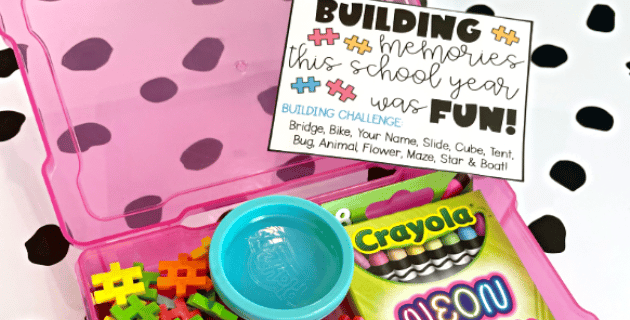
by California Casualty | Educators |
Written by Casey Jeffers, Owner of Fair Winds Teaching & MSEA Second Grade Teacher
The hustle and bustle of the end of the school year is like no other. It comes so quickly; in March I think about all the awesome things I still want to accomplish for the school year. I think I have all the time in the world. Then in the flash of an eye, May is here and I am running around thinking I have no idea how I will be able to fit it all in.

My to-do list grows as the weeks shorten and for me, it’s very bittersweet. I want to be excited about summer and the things I can accomplish during my time off, but I also recognize that most of my students rely on their school home for a sense of security and aren’t very excited for summer to come. I try to calm their fears by letting them know it’s okay to be nervous and excited about summer all at the same time.
This is where I kick into gear! I want to give my students resources to make their summer as enjoyable as possible. Each year I try to think about the students in my class and what they enjoyed. This year my students were OBSESSED with my V.I.P. chair (which they could earn with completed work and outstanding behavior).

One of the highlights of this special seat was the access to limited edition school supplies. The multi-colored changing pen was by far the most popular. They thought it was cooler than sliced bread and this year’s class was full of artists! I knew this was the first thing I needed to buy them to kick off their summer at home. I knew I was sending home their leftover notebooks and sketchbooks so I knew this pen would make a great gift!

You can grab this colorful kid gift tag FREEBIE here and check a list of all my favorite end-of-the-year school gifts here!
Next up, the most popular thing in my room has been the morning STEAM bins! They couldn’t get enough of the building with these materials each morning. If you want to learn more about setting up your own Starting with STEAM bins, check out this blog post I did for California Casualty last summer. They engage your learners and allow them to be super creative. Most of them love the hashtag building blocks I got from Target the most! So when I saw them in little $1 personal tubes, I knew I needed to set them up with a little STEAM station at their houses.

I grabbed 4 x 6 plastic photo boxes, a mini play-doh, a pack of 8 fun glitter crayons, and hashtag building blocks and got to work. The mini play-doh fits perfectly into the plastic bin to close shut. I made these little labels to add a building challenge for them to complete. I told them my email address to take pictures of their creations and send them to me over the summer.
These personal-sized bins also make for a great stress reliever. My students know a lot of peace corner strategies and this is a great way to allow them a break if they are feeling blue.
My students have been very careful about washing their hands all year long and also love any type of yummy-smelling hand sanitizer! Berries, cookies, flowers, linen, and even fresh-cut grass! The kids would bring in the new smells they would find and use them all day long. You can never be too safe and clean. I found some yummy smelling mini kid-safe hand sanitizers that completed our end-of-the-year gifts.

Watching their excitement opening all three little gifts with their tags was sooo much fun! They knew I got things I knew they loved.
Each year it’s important to pick out gifts that reflect what they loved through the school year, it’s fun to stay current and trendy.
In years past, I have had students that were really into a certain read-aloud at school so I would see if it came available through Scholastic books at a discounted or class bundles rate. Then you can add this FREE summer bookmark and challenge your students to finish this Summer Reading Bingo challenge.

Other fun (out-of-the-box) gift ideas:
- Local Coupon – Find a local fun kid-safe activity like an ice cream shop, bouncy house, arcade, theme park, painting class, etc., and ask their business if they have any coupons or would be willing to donate certificates for a free session. I always make sure it’s within walking distance or accessible by the local bus so I know my students and their families would be able to access the location.
- Summer Meetup – Send out an email/letter to families telling them that you will be doing a summer meet-up at a fun kid movie that is playing at the theaters or a local outdoor movie, or pick a local (close to the school) park to have the kids play at. Anyone that comes, I treat some popcorn or icy pops. I make sure I wait until about mid-summer so the kids get to see their classmates and catch up.
- Virtual Yearbook – If you didn’t have time before school ended to do anything, you still have time! If you are a teacher that takes pictures throughout the school year, you can create a virtual yearbook and email out the finished product to your families. It is something they will cherish for a long time. See an example and grab it here. If you weren’t able to take any pictures this school year, bookmark this to think about next year! It is so fun to start at the beginning of the year and add to it slowly as events happen.
- Class Gift – My last favorite idea for end-of-the-year gifts is a class gift for your room to share for years to come. If you don’t like the idea of spending money on smaller items for your students that you don’t think they will love for the long haul, think about spending the same amount of money on a class gift.

You can save $3 per kid (upwards of $75) on smaller stuff and spend less on some good-quality classroom materials. I have done class sets of clipboards, new reading group bags, indoor recess board games, a collection of books, and much more.
Then I created a little golden paper plaque label to place on the item and show the classes years after them that this classroom material is donated in their name. The book boxes of their favorite books with the plaque are so adorable. They are proud and tell the students below them that this is a gift to them.

I make sure I show them that the indoor recess games they play with were donated by kids that are now in 8th grade, they get so excited. As teachers, we spend so much in our classroom, this is a great way to make gifts meaningful and useful for years to come.
Whatever you decide to do for your students, they know they are loved and that they were in good hands this school year. Thank you for doing everything you can to keep them safe and happy. You are an incredible educator!

Casey Jeffers is a second-grade teacher at Butterfly Ridge Elementary in Frederick County, Maryland. She was recently recognized as the national winner of the NEA Foundation’s 2021 Teaching in Excellence Award. Casey is the proud owner of the Education Resource Blog, Fair Winds Teaching, and loves to connect with her education community through her TeacherPayTeacher’s business.

